Engine MITSUBISHI ASX 2014 Owner's Manual (in English)
[x] Cancel search | Manufacturer: MITSUBISHI, Model Year: 2014, Model line: ASX, Model: MITSUBISHI ASX 2014Pages: 418, PDF Size: 14.02 MB
Page 319 of 418
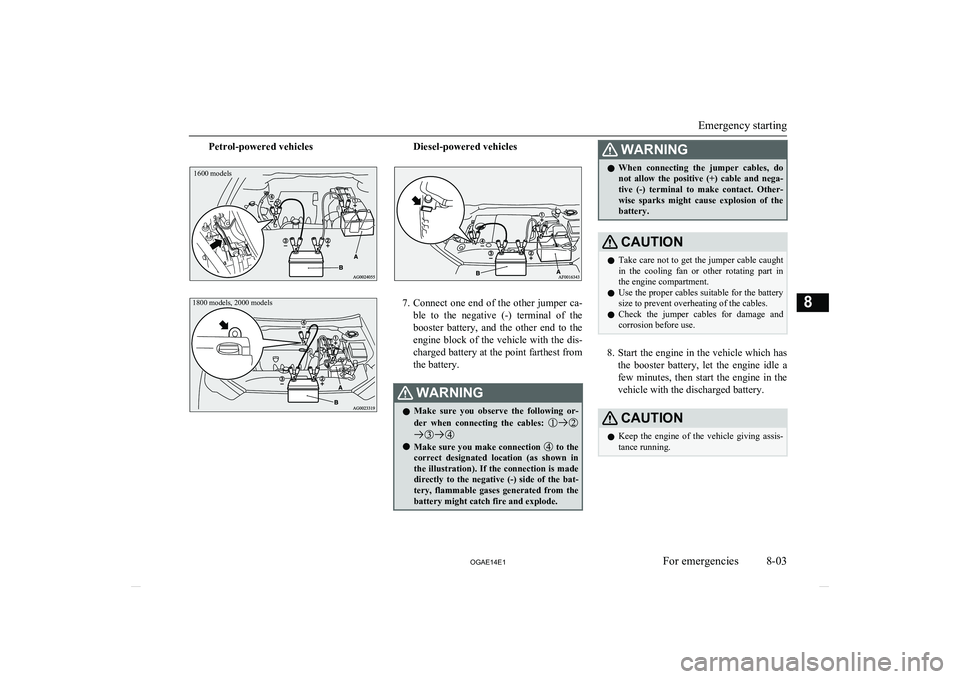
Petrol-powered vehicles1600 models1800 models, 2000 modelsDiesel-powered vehicles
7.Connect one end of the other jumper ca-
ble to the negative (-) terminal of the
booster battery, and the other end to the engine block of the vehicle with the dis-
charged battery at the point farthest from the battery.
WARNINGl Make sure you observe the following or-
der when connecting the cables:
l Make sure you make connection to the
correct designated location (as shown in the illustration). If the connection is made
directly to the negative (-) side of the bat- tery, flammable gases generated from the
battery might catch fire and explode.
WARNINGl When connecting the jumper cables, do
not allow the positive (+) cable and nega-
tive (-) terminal to make contact. Other- wise sparks might cause explosion of the battery.CAUTIONl Take care not to get the jumper cable caught
in the cooling fan or other rotating part in
the engine compartment.
l Use the proper cables suitable for the battery
size to prevent overheating of the cables.
l Check the jumper cables for damage and
corrosion before use.
8. Start the engine in the vehicle which has
the booster battery, let the engine idle a
few minutes, then start the engine in the vehicle with the discharged battery.
CAUTIONl Keep the engine of the vehicle giving assis-
tance running.
Emergency starting
8-03
OGAE14E1For emergencies8
Page 320 of 418

NOTElFor vehicles equipped with the Auto Stop &
Go (AS&G) system, press the “Auto Stop &Go (AS&G) OFF” switch to deactivate theAuto Stop & Go (AS&G) system and pre- vent the engine from automatically stoppingbefore the battery is sufficiently charged.Refer to “To deactivate” on page 6-21.
9. After the engine is started, disconnect
the cables in the reverse order and keep
the engine running for several minutes.
WARNINGl If the battery has to be charged while fit-
ted in the vehicle, disconnect the vehicle side negative (-) terminal connected to the
battery.
l Keep sparks, cigarettes and flames away
from the battery because the battery may produce an explosion.
l Use adequate ventilation when charging
or using the battery in an enclosed space.
l Remove all the caps before charging the
battery.WARNINGl Electrolyte is corrosive diluted sulphuric
acid.
If electrolyte (battery acid) comes into contact with your hands, eyes, clothes and
the painted surface of your vehicle, it should be thoroughly flushed with water.If electrolyte gets in your eyes, flush them
with water immediately and thoroughly, and get prompt medical attention.NOTEl If the vehicle is put in motion without fully
charging the battery, it might cause the loss
of smooth engine operation and the anti-lock brake warning lamp to illuminate.
Refer to “Anti-lock brake system (ABS)” on
page 6-46.Engine overheating
E00800603761
When the engine is overheating, the informa-tion screen in the multi-information display
will be interrupted and the engine coolant
temperature warning display will appear. Al- so “
” will blink.
If this occurs, take the following corrective measures: 1. Stop the vehicle in a safe place.
2. Check whether steam is coming from the
engine compartment.
[If steam does not come from the engine
compartment]
With the engine still running, raise the
bonnet to ventilate the engine compart-
ment.NOTEl For vehicles equipped with the Auto Stop &
Go (AS&G) system, press the “Auto Stop &Go (AS&G) OFF” switch to deactivate theAuto Stop & Go (AS&G) system before stopping the vehicle.
Refer to “To deactivate” on page 6-21.
[If steam is coming from the engine
compartment]
Stop the engine, and when the steam
stops, raise the bonnet to ventilate the engine compartment. Restart the engine.
WARNINGl Do not open the bonnet while steam is
coming from the engine compartment. It
could cause steam or hot water to spurt out, causing burns. Hot water could spurt
out even when there is no steam coming out, and some parts will be very hot. Be
very careful when opening the bonnet.
Engine overheating
8-04 OGAE14E1For emergencies8
Page 321 of 418
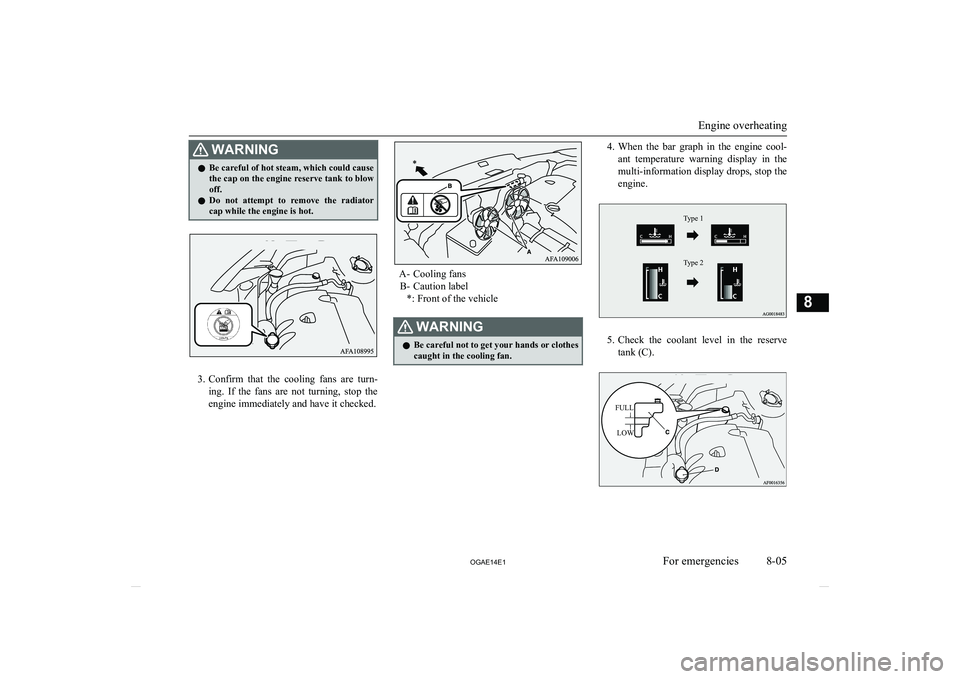
WARNINGlBe careful of hot steam, which could cause
the cap on the engine reserve tank to blow off.
l Do not attempt to remove the radiator
cap while the engine is hot.
3. Confirm that the cooling fans are turn-
ing. If the fans are not turning, stop the
engine immediately and have it checked.
A- Cooling fans
B- Caution label *: Front of the vehicle
WARNINGl Be careful not to get your hands or clothes
caught in the cooling fan.4. When the bar graph in the engine cool-
ant temperature warning display in the
multi-information display drops, stop the
engine.Type 1Type 2Type 1Type 2
5. Check the coolant level in the reserve
tank (C).
Engine overheating
8-05
OGAE14E1For emergencies8 LOW
FULL
Page 322 of 418
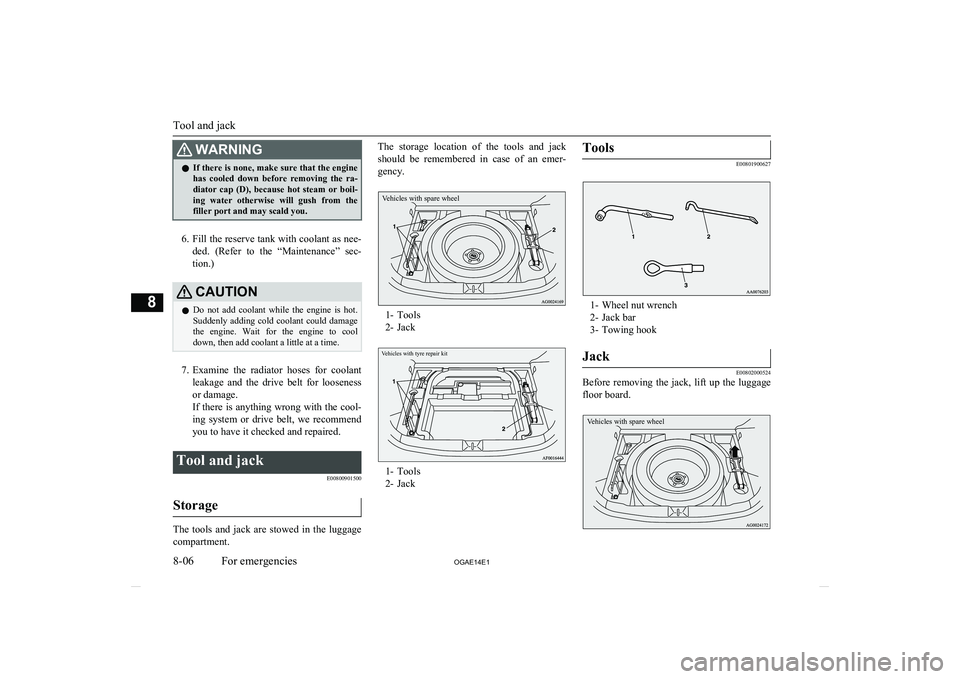
WARNINGlIf there is none, make sure that the engine
has cooled down before removing the ra-
diator cap (D), because hot steam or boil- ing water otherwise will gush from the filler port and may scald you.
6. Fill the reserve tank with coolant as nee-
ded. (Refer to the “Maintenance” sec- tion.)
CAUTIONl Do not add coolant while the engine is hot.
Suddenly adding cold coolant could damage
the engine. Wait for the engine to cool
down, then add coolant a little at a time.
7. Examine the radiator hoses for coolant
leakage and the drive belt for looseness
or damage.
If there is anything wrong with the cool-
ing system or drive belt, we recommend
you to have it checked and repaired.
Tool and jack
E00800901500
Storage
The tools and jack are stowed in the luggagecompartment.
The storage location of the tools and jack
should be remembered in case of an emer-
gency.Vehicles with spare wheel
1- Tools
2- Jack
1- Tools
2- Jack
Tools
E00801900627
1- Wheel nut wrench
2- Jack bar
3- Towing hook
Jack
E00802000524
Before removing the jack, lift up the luggage floor board.
Vehicles with spare wheel
Tool and jack
8-06 OGAE14E1For emergencies8 Vehicles with tyre repair kit
Page 324 of 418
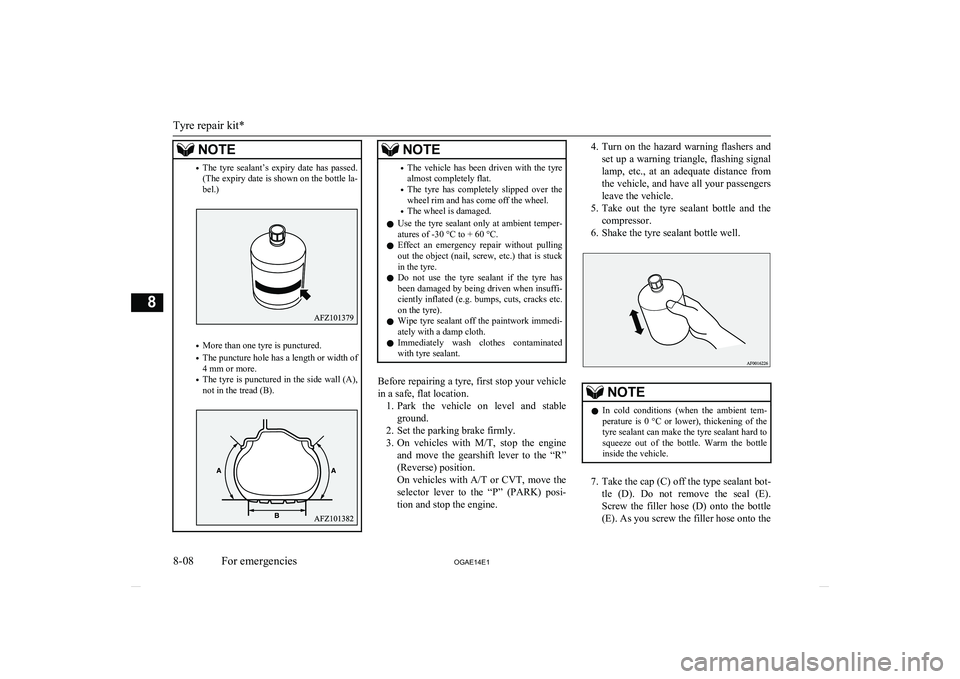
NOTE•The tyre sealant’s expiry date has passed.
(The expiry date is shown on the bottle la- bel.)
• More than one tyre is punctured.
• The puncture hole has a length or width of
4 mm or more.
• The tyre is punctured in the side wall (A),
not in the tread (B).
NOTE• The vehicle has been driven with the tyre
almost completely flat.
• The tyre has completely slipped over the
wheel rim and has come off the wheel.
• The wheel is damaged.
l Use the tyre sealant only at ambient temper-
atures of -30 °C to + 60 °C.
l Effect an emergency repair without pulling
out the object (nail, screw, etc.) that is stuck
in the tyre.
l Do not use the tyre sealant if the tyre has
been damaged by being driven when insuffi- ciently inflated (e.g. bumps, cuts, cracks etc.
on the tyre).
l Wipe tyre sealant off the paintwork immedi-
ately with a damp cloth.
l Immediately wash clothes contaminated
with tyre sealant.
Before repairing a tyre, first stop your vehicle
in a safe, flat location. 1. Park the vehicle on level and stable
ground.
2. Set the parking brake firmly.
3. On vehicles with M/T, stop the engine
and move the gearshift lever to the “R”
(Reverse) position.
On vehicles with A/T or CVT, move the
selector lever to the “P” (PARK) posi- tion and stop the engine.
4. Turn on the hazard warning flashers and
set up a warning triangle, flashing signal
lamp, etc., at an adequate distance from
the vehicle, and have all your passengers
leave the vehicle.
5. Take out the tyre sealant bottle and the
compressor.
6. Shake the tyre sealant bottle well.NOTEl In cold conditions (when the ambient tem-
perature is 0 °C or lower), thickening of the
tyre sealant can make the tyre sealant hard to squeeze out of the bottle. Warm the bottleinside the vehicle.
7. Take the cap (C) off the type sealant bot-
tle (D). Do not remove the seal (E). Screw the filler hose (D) onto the bottle
(E). As you screw the filler hose onto the
Tyre repair kit*
8-08 OGAE14E1For emergencies8
Page 329 of 418
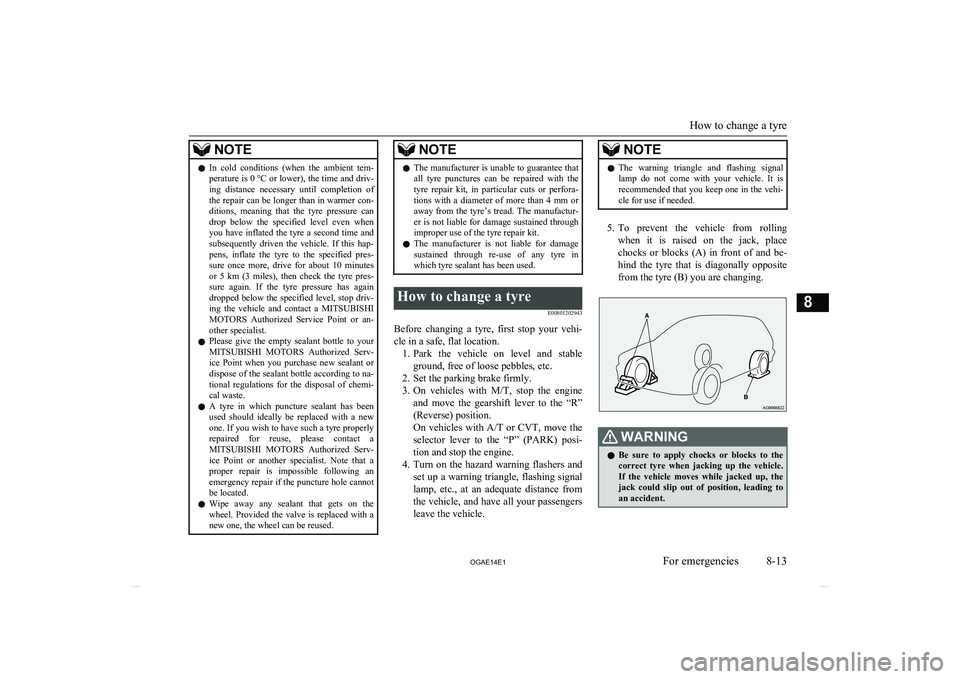
NOTElIn cold conditions (when the ambient tem-
perature is 0 °C or lower), the time and driv-
ing distance necessary until completion of
the repair can be longer than in warmer con- ditions, meaning that the tyre pressure candrop below the specified level even when
you have inflated the tyre a second time and
subsequently driven the vehicle. If this hap- pens, inflate the tyre to the specified pres-
sure once more, drive for about 10 minutes or 5 km (3 miles), then check the tyre pres-sure again. If the tyre pressure has again
dropped below the specified level, stop driv- ing the vehicle and contact a MITSUBISHI
MOTORS Authorized Service Point or an-
other specialist.
l Please give the empty sealant bottle to your
MITSUBISHI MOTORS Authorized Serv-
ice Point when you purchase new sealant or
dispose of the sealant bottle according to na- tional regulations for the disposal of chemi-
cal waste.
l A tyre in which puncture sealant has been
used should ideally be replaced with a new one. If you wish to have such a tyre properly repaired for reuse, please contact a
MITSUBISHI MOTORS Authorized Serv-
ice Point or another specialist. Note that a
proper repair is impossible following an emergency repair if the puncture hole cannot
be located.
l Wipe away any sealant that gets on the
wheel. Provided the valve is replaced with anew one, the wheel can be reused.NOTEl The manufacturer is unable to guarantee that
all tyre punctures can be repaired with the tyre repair kit, in particular cuts or perfora-
tions with a diameter of more than 4 mm or
away from the tyre’s tread. The manufactur-
er is not liable for damage sustained through improper use of the tyre repair kit.
l The manufacturer is not liable for damage
sustained through re-use of any tyre in which tyre sealant has been used.How to change a tyre
E00801202943
Before changing a tyre, first stop your vehi-cle in a safe, flat location. 1. Park the vehicle on level and stable
ground, free of loose pebbles, etc.
2. Set the parking brake firmly.
3. On vehicles with M/T, stop the engine
and move the gearshift lever to the “R”
(Reverse) position.
On vehicles with A/T or CVT, move the
selector lever to the “P” (PARK) posi- tion and stop the engine.
4. Turn on the hazard warning flashers and
set up a warning triangle, flashing signal
lamp, etc., at an adequate distance from the vehicle, and have all your passengers
leave the vehicle.
NOTEl The warning triangle and flashing signal
lamp do not come with your vehicle. It is recommended that you keep one in the vehi- cle for use if needed.
5. To prevent the vehicle from rolling
when it is raised on the jack, place
chocks or blocks (A) in front of and be- hind the tyre that is diagonally opposite
from the tyre (B) you are changing.
WARNINGl Be sure to apply chocks or blocks to the
correct tyre when jacking up the vehicle.If the vehicle moves while jacked up, the
jack could slip out of position, leading to
an accident.
How to change a tyre
8-13
OGAE14E1For emergencies8
Page 332 of 418
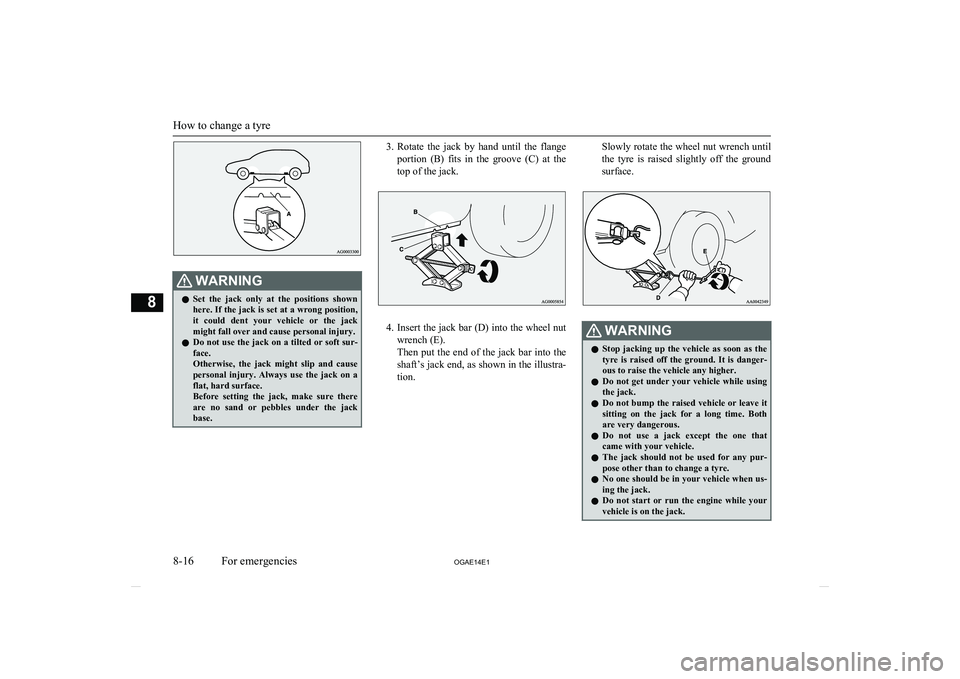
WARNINGlSet the jack only at the positions shown
here. If the jack is set at a wrong position, it could dent your vehicle or the jack
might fall over and cause personal injury.
l Do not use the jack on a tilted or soft sur-
face.
Otherwise, the jack might slip and cause
personal injury. Always use the jack on a flat, hard surface.
Before setting the jack, make sure there
are no sand or pebbles under the jack base.3. Rotate the jack by hand until the flange
portion (B) fits in the groove (C) at the
top of the jack.
4. Insert the jack bar (D) into the wheel nut
wrench (E).
Then put the end of the jack bar into the
shaft’s jack end, as shown in the illustra- tion.
Slowly rotate the wheel nut wrench until
the tyre is raised slightly off the ground
surface.WARNINGl Stop jacking up the vehicle as soon as the
tyre is raised off the ground. It is danger-
ous to raise the vehicle any higher.
l Do not get under your vehicle while using
the jack.
l Do not bump the raised vehicle or leave it
sitting on the jack for a long time. Both are very dangerous.
l Do not use a jack except the one that
came with your vehicle.
l The jack should not be used for any pur-
pose other than to change a tyre.
l No one should be in your vehicle when us-
ing the jack.
l Do not start or run the engine while your
vehicle is on the jack.
How to change a tyre
8-16 OGAE14E1For emergencies8
Page 336 of 418

NOTElThe wheel cover is made of plastic. Pry it
loose carefully.
To install
1. Make sure the tabs (A) of the back of the
wheel cover are not broken and correctly fitted on the rings (B). If in doubt, do not install the wheel cover and consult aMITSUBISHI MOTORS Authorized
Service Point.
2. Align the air valve (C) of the tyre with
the notch (D) in the wheel cover.
NOTEl Full wheel covers have a symbol mark (E)
provided on the reverse side to show the air
valve location.
Before installing the wheel cover to the wheel, make sure that the opening with the
symbol mark is correctly aligned with the air valve.
3. Push the underside (F) of the wheel cov-
er into the wheel.
4. Gently push both sides (G) of the wheel
cover and hold them in place with both knees.
5. Gently tap around the circumference of
the wheel cover at the top (H), then push
the wheel cover into place.Towing
E00801505064
If your vehicle needs to be tow-
ed
If you need to tow your vehicle, we recom- mend that you contact a MITSUBISHI
MOTORS Authorized Service Point or tow
truck company.
In the following cases, transport the vehicle
using a tow truck.
l The engine runs but the vehicle does not
move or abnormal noise is produced.
Towing
8-20 OGAE14E1For emergencies8
Page 338 of 418
![MITSUBISHI ASX 2014 Owners Manual (in English) CAUTIONl[For 2WD vehicles equipped with the Active
Stability Control (ASC)]
If the vehicle is towed with the ignition switch in the “ON” position or the operation
mode in ON and only the fr MITSUBISHI ASX 2014 Owners Manual (in English) CAUTIONl[For 2WD vehicles equipped with the Active
Stability Control (ASC)]
If the vehicle is towed with the ignition switch in the “ON” position or the operation
mode in ON and only the fr](/img/19/34863/w960_34863-337.png)
CAUTIONl[For 2WD vehicles equipped with the Active
Stability Control (ASC)]
If the vehicle is towed with the ignition switch in the “ON” position or the operation
mode in ON and only the front wheels or on- ly the rear wheels raised off the ground (Type B or C), the ASC may operate, result-
ing in an accident.
When towing the vehicle with the rear wheels raised, turn the ignition switch to the
“ACC” position or put the operation mode in ACC.
When towing the vehicle with the front wheels raised, keep the ignition switch or the
operation mode as follows.
[Except for vehicles equipped with keyless operation system]
The ignition switch is in the “LOCK” or
“ACC” position.
[Vehicles equipped with keyless operation system]
The operation mode is in OFF or ACC.
Towing with rear wheels off the
ground (Type B)
Place the gearshift lever in the “N” (Neutral) position.
Turn the ignition switch to the “ACC” posi-
tion or put the operation mode in ACC and secure the steering wheel in a straight-ahead
position with a rope or tiedown strap. Never place the ignition switch in the “LOCK” po-sition or put the operation mode in OFF when towing.
Towing with front wheels off the ground (Type C)
Release the parking brake.
Place the gearshift lever in the “N” (Neutral) position ( M/T) or the selector lever in the
“N” (NEUTRAL) position (CVT).
Emergency towing
If towing service is not available in an emer-
gency, your vehicle may be temporarily tow- ed by a rope secured to the towing hook.If your vehicle is to be towed by another ve-
hicle or if your vehicle tows another vehicle, pay careful attention to the following points:
If your vehicle is to be towed byanother vehicle
1. The front towing hook (A) is located as
shown in the illustration. Secure the tow
rope to the front towing hook.
NOTEl Do not use the tie-down hooks (B) for tow-
ing. These hooks are provided only for thepurpose of transporting the vehicle itself.
Using any part other than the designated
towing hook (A) could result in damage to
the vehicle body.
l Using a wire rope or metal chain can result
in damage to the vehicle body. It is best to
use a non-metallic rope. If you use a wire
rope or metal chain, wrap it with cloth at any point where it touches the vehicle body.
l Take care that the tow rope is kept as hori-
zontal as possible. An angled tow rope can damage the vehicle body.
2. Keep the engine running.
If the engine is not running, perform the
following operation to unlock the steer- ing wheel.
[Except for vehicles with keyless opera-
tion system]
Towing
8-22 OGAE14E1For emergencies8
Page 339 of 418
![MITSUBISHI ASX 2014 Owners Manual (in English) Turn the ignition switch to the “ACC” or
“ON” position ( M/T) or “ON” position
(A/T or CVT).
[For vehicles with the keyless operation
system]
Put the operation mode in ACC MITSUBISHI ASX 2014 Owners Manual (in English) Turn the ignition switch to the “ACC” or
“ON” position ( M/T) or “ON” position
(A/T or CVT).
[For vehicles with the keyless operation
system]
Put the operation mode in ACC](/img/19/34863/w960_34863-338.png)
Turn the ignition switch to the “ACC” or
“ON” position ( M/T) or “ON” position
(A/T or CVT).
[For vehicles with the keyless operation
system]
Put the operation mode in ACC or ON (M/T) or ON (A/T or CVT).NOTEl For vehicles equipped with the Auto Stop &
Go (AS&G) system, press the “Auto Stop &Go (AS&G) OFF” switch to deactivate theAuto Stop & Go (AS&G) system before stopping the vehicle.
Refer to “To deactivate” on page 6-21.WARNINGl When the engine is not running, the brake
booster and power steering system do not
operate. This means higher brake depres- sion force and higher steering effort arerequired. Therefore, vehicle operation is more difficult than usual.CAUTIONl Do not leave the ignition switch in the
“LOCK” position or the operation mode in
OFF. The steering wheel will lock, causing loss of control.3. Place the gearshift lever in the “N”
(Neutral) position ( M/T), or the selector
lever in the “N” (NEUTRAL) position
(A/T or CVT).
4. Turn on the hazard warning lamps if re-
quired by law. (Follow the local driving
laws and regulations.)
5. During towing make sure that close con-
tact is maintained between the drivers of both vehicles, and that the vehicles trav-
el at low speed.CAUTIONl The person in the vehicle being towed must
pay attention to the brake lamps of the tow- ing vehicle and make sure the rope never be-
comes slack.
l Avoid sudden braking, sudden acceleration
and sharp turning; such operation could cause damage to the towing hooks or the tow
rope.
People in the vicinity could be injured as a
result.
l When towing or being towed down a long
slope, the brakes may overheat reducing the effectiveness. In this situation, have your ve-hicle transported by a tow truck.CAUTIONl When the vehicle equipped with
A/T or
CVT is to be towed by another vehicle with
the all wheels on the ground, make sure that the towing speed and distance given below
are never exceeded, causing damage to the
transmission.
Towing speed: 40 km/h (25 mph)
Towing distance: 40 km (25 miles)
For the towing speed and the towing dis- tance, follow the local driving laws and reg- ulations.
If your vehicle tows another ve-
hicle
1. Take out the towing hook, wheel nut
wrench and jack bar.
Refer to “Tools, jack and tyre repair kit”
on page 8-06.
Towing
8-23
OGAE14E1For emergencies8